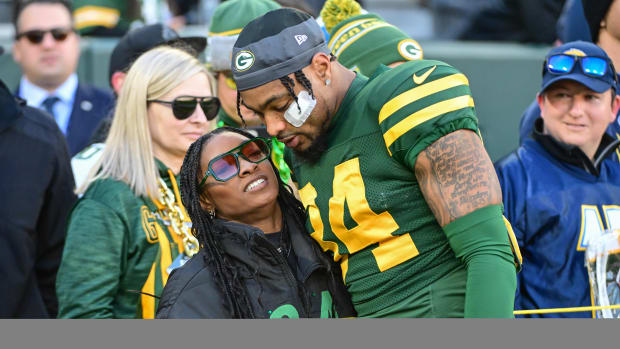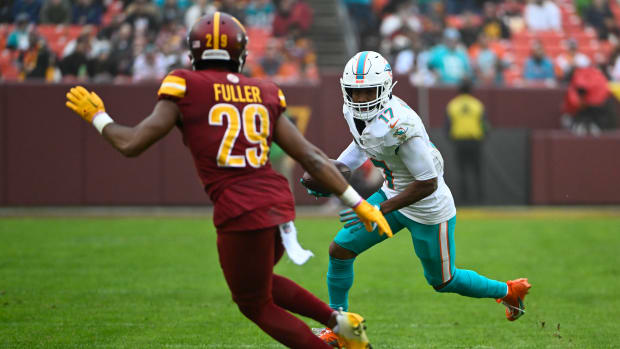Ben Roethlisberger Is a Convenient Scapegoat, But the Steelers Have Larger Issues
The final meaningful play of the Steelers’ stunning 24–10 loss to the Bengals on Sunday was, from the outside looking in, a check-down pass to a running back on fourth-and-10 in which the back received the ball a full 17 yards from the first down marker with six defenders to beat.
It was easy for as all to make fun of, using it as some kind of indictment on Ben Roethlisberger’s age, characterizing him as some kind of tired old man who would rather just waddle off the field and call it a night than dance around the pocket and try to make something happen. But the truth was that the Bengals were playing what Roethlisberger called a “picket fence zone,” which he wisely identified despite the fact that Cincinnati had disguised it a bit at the snap. Usually, a play like the one the Steelers were supposed to run in that situation is actually the right call. Pittsburgh wanted Najee Harris to get the ball with some space to run and hoped to free some offensive linemen to get out in front and block. The play would have taken advantage of the back’s momentum, theoretically giving him a chance to bowl over the defensive backs sitting on their heels at the first-down marker.
But it was what Roethlisberger said afterward that seemed to be more indicative of his current situation.
“Hindsight, you know, maybe we should have taken a shot in the end zone,” Roethlisberger said. “I wish I had done that.”
This could have been the rehearsed line of a player who is going to receive most of the blame for Pittsburgh’s current, less-than-ideal place at the bottom of the AFC North. He could not say, for example, that Harris dropped four balls in the second half or that Pittsburgh’s seven total second-half drops were the most in a second half since 2006, according to ESPN Stats and Information. He could not say that he has the lowest snap to throw time in the NFL, or that heading into Sunday he had been pressured on more than 30% of his snaps.
For sure, Sunday’s loss to the Bengals illustrated just how stuck the Steelers are. They field a competitive team in part because their quarterback can still dissect and recognize opposing defenses and get rid of the ball quickly, but they have yet to figure out how to correctly meld a game plan with his current physical reality. Some clubs can do this rather quickly. It took the Buccaneers a little more than half a season to find the midway point between what Tom Brady was capable of and what Bruce Arians had always expected. Pittsburgh is still crawling its way through that swamp.
And this team will absolutely finish this season better in the final standings than it would be if it was fielding a rookie quarterback. Look around the league on Sunday at what the QB class of 2021 is offering us thus far, and you can follow that thought process even if you chose to disagree with it. But are the Steelers putting off the inevitable developmental year of a future quarterback in exchange for something worthwhile? Or will 2021 ultimately be the year that no one calling the shots in Pittsburgh, or calling into talk radio believing they should, will be right?
That’s the other strange thing about Roethlisberger’s comment: that it also seemed to contain a twinge of what he knew he knew things may have been like in seasons past. Sure, the right call in this moment may have been to load up his first-round back with space and blockers, trying to bust the picket fence zone like a wedge player on a kickoff. But maybe there was a time when Roethlisberger could have simply hung in the pocket, allowing defenders to roll off him like brow sweat, and threaded a missile in between defenders.
Maybe there was a time when Roethlisberger didn’t need to target his running back an astounding 19 times over the course of a game, largely ignoring the upper third of the field, save for a handful of attempts deep and to the left.
So it goes, for a team that seems to be turning in opposite directions all at once. There is a quarterback who can still typically be useful enough to avoid a loss to the surprisingly competent Bengals, though not nearly as good as he once was. There is a collection of explosive skill-position players inflating expectations. There is an offensive line struggling and a new coordinator trying to tie it all together. The quarterback may be the convenient person to blame here. But the context around him should color how you watch a season that is somehow both going how many of us expected and yet still surprising to watch unfold.
More NFL Coverage:
• Week 3 NFL Takeaways: Justin Tucker Is the Ultimate Weapon
• Early Losses a Warning Sign for the Chiefs
• Jags Score Kick–Six TD as Cardinals Miss 68-Yard FG
• WFT Kicker Dustin Hopkins Recovers Own Kickoff





































